Discovering the rich variety of “lizards in New Mexico” is an adventure into the heart of the state’s diverse habitats, from sprawling forests to vast deserts and serene marshes. Home to an estimated 46 species of lizards, some of which are introduced, New Mexico serves as a grand stage for these fascinating creatures.
Each lizard species exhibits unique traits, including distinct colors, behaviors, and locations within the state. Although some of these reptiles may appear strikingly similar, detailed observation can reveal the subtle differences that set them apart.
In this comprehensive guide, we’ll delve into the world of New Mexico’s lizards, offering insights into the distinctive characteristics of each species. So let’s embark on this journey, exploring the 46 lizard species that bring a vibrant touch of nature to the landscapes of New Mexico.
Table of Contents
Lizards in New Mexico
Dactyloidae
1. Brown Anole
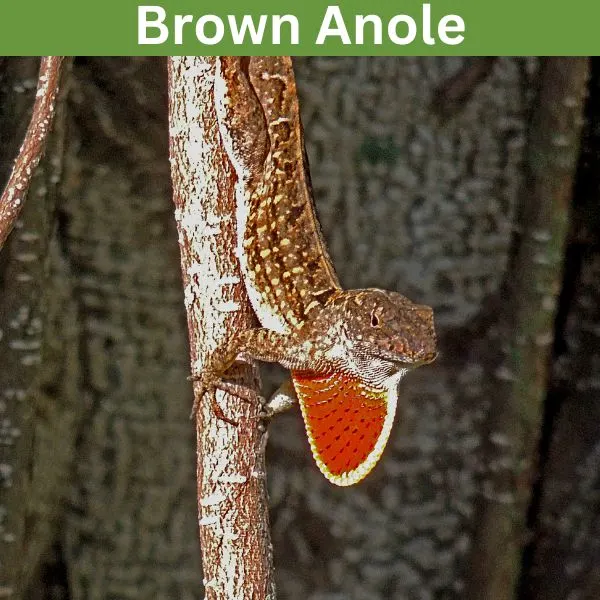
- Experience Level: Beginner
- Family: Dactyloidae
- Scientific Name: Anolis sagrei
- Other Names: Bahaman Anole, Cuban Brown Anole
- Adult Size: 5 to 9 in. (12 to 22.86 cm)
- Lifespan: 5 years
- Average Price Range: $10
Brown anoles are a lizard species native to Cuba, and the Bahamas. They are a species introduced to New Mexico, and other regions in the United States, and around the globe. Brown anoles live in warm, and tropical habitats. They are active in the day, and are often seen in places like forests, and urban places.
The color of this lizard ranges from brown to grayish. Males of this species have a dewlap under their chin, which have an orangish, or red coloring. Brown anoles have wrinkly skin, long tails, and a robust body. This lizard may have white, or orange markings on their back, and a pale underside.
These lizards are sometimes seen climbing on objects like trees, but are less arboral than other anoles. As the only anole species in New Mexico this lizard is easy to identify, but is not very common. They feed on smaller insects, and invertebrates.
Brown anoles breed in the warm months, laying their eggs in moist soil. This lizard species was introduced to the United States in the 1800s, by stowing away on cargo ships from the Caribbean. The hardy nature of anoles make them good pets, and also give them invasive capabilities.
Anguidae
2. Arizona Alligator Lizard

- Experience Level: Intermediate
- Family: Anguidae
- Scientific Name: Elgaria kingii
- Other Names: Madrean Alligator Lizard
- Adult Size: 5.5 in. (14 cm.)
- Lifespan: 8 to 15 years
- Average Price Range: $350
The Arizona alligator lizard is native to New Mexico, Arizona, and Mexico. In New Mexico this lizard lives in the southwestern corner of the state. Semi-desert grasslands, foothills, mountains, and low valleys are the habitats these lizards live in.
Arizona alligator lizards are a larger lizard, with long bodies, small limbs, and thick tails. This species has a tan, to gray coloring, with a dark striped pattern running down their body. The bellies of these lizards are black and white, painted with a mottled pattern. Male alligator lizards have larger broad heads. The scales of these lizards are smooth, and square shaped.
The day, and early morning is when the Arizona alligator lizard is active. They are a terrestrial species, using things like leaf litter, and rocks to hide under. The spring and summer months are when these lizards are active most, hibernating when the cold comes.
Crotaphytidae
3. Eastern Collared Lizard

- Experience Level: Intermediate
- Family: Crotaphytidae
- Scientific Name: Crotaphytus collaris
- Other Names: Yellow-headed Collared Lizard
- Adult Size: 8 to 15 in. (20 to 38 cm.)
- Lifespan: 10 to 12 years
- Average Price Range: $70
The eastern collared lizards are found across New Mexico, and are native to North America. These lizards live in desert and rocky environments. They are active during the day, and are often seen basking in the sun.
Collared lizards are named after the marking that appears around their neck, which is black and white, and resembles a collar. Olive, brown, yellow, and blue are the colors this species appears in. They have stripes on their tails, with a blotched pattern on their back.
The toes of these lizards are very long, which help them travel over their sandy habitat. In the breeding season eastern collared lizards may develop more colors of yellow, or orange on them. Spring and summer is when these lizards mate, laying around 4 to 6 eggs.
Eastern collared lizards are very quick, able to reach up to 15 mph (24 kph). Their speed is used to escape predators like hawks, snakes, coyotes, and carnivorous mammals. Being quick also helps the eastern collared lizard feed on invertebrates like grasshoppers, spiders, and beetles. When running you may sometimes see the eastern collared lizard get on two legs, running bipedally.
4. Sonoran Collared Lizard

- Experience Level: Intermediate
- Family: Crotaphytidae
- Scientific Name: Crotaphytus nebrius
- Other Names: n/a
- Adult Size: 8 to 15 in. (20 to 38 cm.)
- Lifespan: 10 to 12 years
- Average Price Range: n/a
Native to the United States, the Sonoran collared lizard is found within New Mexico. Like their name suggests these lizards can be found in the Sonoran desert. They live in desert grasslands, sagebrush, and pinyon-juniper habitats. Rocky, and semi-arid environments is where these lizards prefer to live.
Sonoran collared lizards have a black collared marking around their neck. They have olive, brown, bluish and yellow coloring. This species has a blotched pattern on them, with white bellies. When pregnant, females may have reddish blotches on them.
Summer and spring is when these lizards are active most, but younger specimens can be active in the fall. Grasshoppers, beetles, and small reptiles are some of the prey this lizard eats. Currently this lizard population is considered stable, and not threatened.
5. Long-nosed Leopard Lizard

- Experience Level: Intermediate
- Family: Crotaphytidae
- Scientific Name: Gambelia wislizenii
- Other Names: n/a
- Adult Size: 3.25 to 5.75 in. (8.225 to 14.6 cm.)
- Lifespan: 5 to 8 years
- Average Price Range: $20
Long-nosed leopard lizards are found in most of New Mexico. These lizards in semi-arid habitats with sparse vegetation, found up to 6,000 ft. (1,800 m.) above sea level. Valleys, and hilly environments with desert vegetation is where this lizard is seen most.
In the deserts of where they live the long-nosed leopard lizard is one of the largest lizard species. This species has a tan, to golden coloring, with dark blotches covering them. When born juveniles look similar to adults, but can have more vibrant colors, with yellow and orange on them.
Long-nosed leopard lizards are active in the day, and enjoy basking in the sun early morning. These lizards feed on smaller lizards, and other invertebrates. They are prey for animals like road-runners, coyotes, and other desert carnivores.
Helodermatidae
6. Gila Monster

- Experience Level: Advanced
- Family: Helodermatidae
- Scientific Name: Heloderma suspectum
- Other Names: n/a
- Adult Size: 10.2 to 14.1 in. (26 to 36 cm)
- Lifespan: 20 to 36 years
- Average Price Range: $1,200
Gila monsters are native to New Mexico, and live in the southeastern corner of the state. This species is the largest lizard in New Mexico. Gila monsters are a burrowing species, using their claws to dig, or occupying pre-built burrows. These lizards are not seen often since they are mainly active in the spring, and only leave their burrows in the morning.
Robust in size, the gila monster has a thick body with short legs. They have beaded scales, with black, and orange coloring. Gila monsters bodies are relatively flat, and their skin can sometimes appear pinkish.
The diet of this lizard is made up of small mammals, birds, eggs, and other reptiles. They face many predators like foxes, cats, dogs, rattle snakes, and roadrunners. The gila monster’s venom is used to catch prey, and they have grooved teeth to administer venom.
The venom of the gila monster is a neurotoxin that is produced in small amounts. While not typically fatal to humans, their bite can cause symptoms like weakness, dizziness, a change in blood pressure, nausea, and a fast heart rate.
Phrynosomatidae
7. Common side-blotched Lizard

- Experience Level: Beginner
- Family: Phrynosomatidae
- Scientific Name: Uta stansburiana
- Other Names: n/a
- Adult Size: 1.5 to 2.5 in. (3.8 to 6.35 cm.)
- Lifespan: 1 year
- Average Price Range: $12
Common side-blotched lizards are found in most of New Mexico, and are native to the western United States. Habitats like semi desert grasslands, and desert scrub are places where this lizard lives. They are common near areas with sand dunes, and sparse rocky areas.
The common side-blotched lizard is a smaller to medium sized lizard. They have olive to tan coloring, with specks that can appear yellow, orange, or bluish on them. These lizards have roughly keeled scales on their tail, and long toes.
There are several morphs of these lizards, and they can have an orange, blue, or yellow throat. Some morphs are quicker, and more aggressive with each other. The morphs mating habits vary, and each one has their own advantage.
Feeding is based on sex, and behavior, and the majority of these lizards’ diet is made up of mostly arthropods. Common side-blotched lizards’ lifespan can be shortened by parasites and predators, but in their overall range they have a stable population.
8. Ornate Tree Lizard

- Experience Level: Intermediate
- Family: Phrynosomatidae
- Scientific Name: Urosaurus ornatus
- Other Names: n/a
- Adult Size: 2.3 in. (5.84 cm.)
- Lifespan: 3 years
- Average Price Range: n/a
Ornate tree lizards are native to New Mexico, found in the western portion of the state. Wooded riparian habitats, desert wash, and rocky regions with lots of places to climb is where this lizard lives. Ornate tree lizards enjoy climbing on things like rocks, trees, and fences, and are active in the day.
These lizards are medium sized, with gray, to brownish coloring. They have roughly keeled tails, with males having blue coloring under their chins. Ornate tree lizards have a dark blotched pattern on them.
Every month but winter is when these lizards can be sighted. They feed on insects, plants, fruit, and invertebrates they find. There are several subspecies of these lizards that can be found, and this lizard has a stable population.
9. Long-tailed Brush Lizard

- Experience Level: Intermediate
- Family: Phrynosomatidae
- Scientific Name: Urosaurus graciosus
- Other Names: n/a
- Adult Size: 1.8 to 2.5 in. (4.7 to 6.6 cm)
- Lifespan: 5 years
- Average Price Range: n/a
Long-tailed brush lizards are found in the northwestern region in New Mexico. Habitats within the Mojave and Sonaran desert are where this species can be found in the United States. Long-tailed brush lizards are common in rocky canyons, woodlands, and enjoy basking in the sun.
The long tail of this lizard can help identify them from other similar species, which can sometimes grow more than double their body. Long-tailed brush lizards have tan, to dark brown coloring, with a mottled coloring on them. They can sometimes have a greenish, and orange marking on their underside.
Found in the day, these lizards spend their early morning climbing, and looking for food. They eat animals like termites, beetles, grasshoppers, spiders, and scorpions. The winter and fall is when these lizards hibernate, emerging later in the spring.
10. Southwestern Fence Lizard

- Experience Level: Intermediate
- Family: Phrynosomatidae
- Scientific Name: Sceloporus cowlesi
- Other Names: White Sands Swift, Cowles’ Prairie Lizard
- Adult Size: 3 to 8.4 in. (7.6 to 21.33 cm.)
- Lifespan: 5 to 7 years
- Average Price Range: $20
The southwestern fence lizard is found in the majority of New Mexico. Rocky regions, and wooded habitats is where this species lives, and they are often found in urban areas. This species has a stable population in their range.
Southwestern fence lizards are small with brown, tan, or a golden color. They have roughly keeled scales, with striped markings that appear on their side. This lizard may have bright blue coloring on their belly, which females lack. When pregnant females can have orange specks on them.
Southwestern fence lizards enjoy climbing, and are often seen on fences, or rocks. They bask in the sun during the day, and hibernate when temperatures get too cold in fall, and winter. Wasps, larvae, ants, and beetles are what this species eats, chasing down their prey.
11. Plateau Fence Lizard
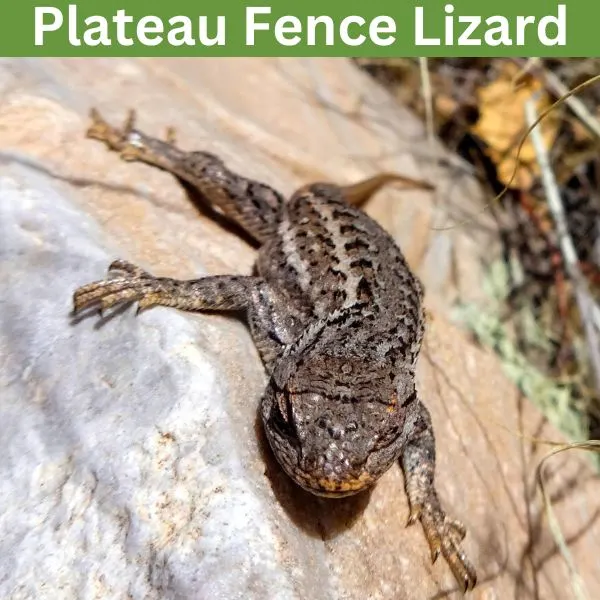
- Experience Level: Intermediate
- Family: Phrynosomatidae
- Scientific Name: Sceloporus tristichus
- Other Names: Pine lizard
- Adult Size: 4 to 7.5 in. (10 to 19 cm.)
- Lifespan: 5 to 7 years
- Average Price Range: n/a
Plateau fence lizards are found in the northern region of New Mexico. These lizards live in rocky, wooded habitats. They enjoy climbing on objects like fences, rocks, and fallen trees. This species is active in the day, mostly seen in the mornings.
Medium in size, the plateau fence lizard has gray to brownish coloring. They sometimes appear green, and have very roughly keeled scales on their body. Plateau fence lizards that are male have a bluish belly. This species has dark chevron markings on their back.
Plateau fence lizards are inactive during the very hot periods of summer, and the cold seasons in fall and winter. They feed on small insects, spiders, and various arthropods. Plateau fence lizards coloring helps them camouflage, and if spotted they will flee for cover.
12. Prairie Lizard

- Experience Level: Intermediate
- Family: Phrynosomatidae
- Scientific Name: Sceloporus consobrinus
- Other Names: Southern Prairie Lizard
- Adult Size: 4 to 7 in. (10.16 to 17.78 cm.)
- Lifespan: n/a
- Average Price Range: n/a
In New Mexico the prairie lizard is a species found on the eastern border of the state. This species lives in habitats like prairies, sand dunes, grasslands, and rocky outcrops. They are active in the day, and enjoy basking in the sun on rocks, logs, and other objects.
Prairie lizards are a smaller, to medium sized species. They have brown, or gray coloring, usually with stripes running down them. The belly and throat of this species is sometimes blue. The scales of these lizards are keeled, and their tails are very long.
In the winter this lizard enters a state of brumation, but may emerge on warmer days to bask in the sun. They breed in the spring, laying an average of 5 eggs in their clutch. Prairie lizards feed on insects, and arthropods.
13. Twin-spotted Spiny Lizard

- Experience Level: Intermediate
- Family: Phrynosomatidae
- Scientific Name: Sceloporus bimaculosus
- Other Names: n/a
- Adult Size: 5 to 13 in. (12.7 to 33.02 cm.)
- Lifespan: 2 to 7 years
- Average Price Range: n/a
Twin-spotted spiny lizards are native to New Mexico, and Texas, with their range also extending to Mexico. In New Mexico this species can be found in the southwestern corner of the state. Rocky desert habitats is where this species lives.
A large lizard, this species has yellowish, to brown coloring. Males of this species are slightly larger than females. These lizards have very keeled scales, with dark markings on their back.
Twin-spotted spiny lizards are active in the day, spending their time feeding on small insects, and other invertebrates. This species is often confused with other spiny lizards, as they have a similar appearance, and behavior.
14. Desert Spiny Lizard
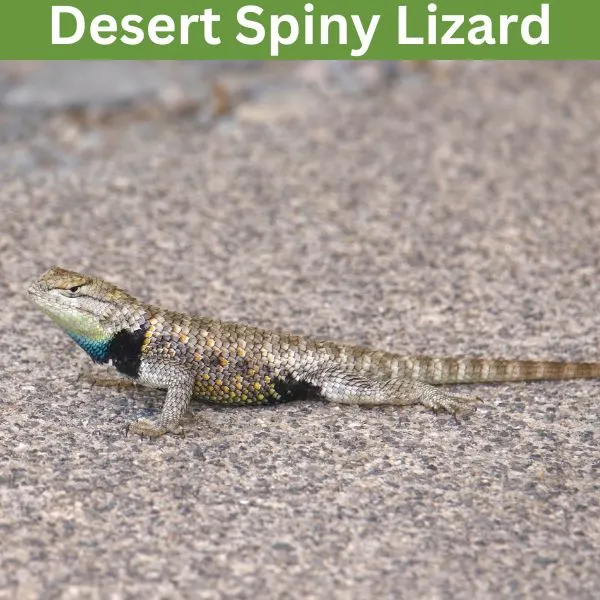
- Experience Level: Intermediate
- Family: Phrynosomatidae
- Scientific Name: Sceloporus magister
- Other Names: n/a
- Adult Size: 2.4 to 5.4 in. (6.3 to 13.8 cm)
- Lifespan: 2 to 7 years
- Average Price Range: $20
The desert spiny lizard is native to New Mexico, and they are found in the western portion of the state. These lizards live in woodlands, valleys, and other similar semi-arid environments. Desert spiny lizards are an arboreal species that enjoy climbing on trees and other structures.
Desert spiny lizards have a black collar marking on their neck, with dark markings on their back. They have roughly keeled scales, with tannish, to gray coloring. Greenish, or blue markings also appear on these lizards.
These lizards are able to change their shade to make their bodies cooler. Their coloring also is used as camouflage to hide from predators. Desert spiny lizards when not active hide in a shady area, or place like a burrow.
15. Striped Plateau Lizard

- Experience Level: Intermediate
- Family: Phrynosomatidae
- Scientific Name: Sceloporus virgatus
- Other Names: n/a
- Adult Size: 2.8 to 7.5 in. (7.2 to 19.05 cm.)
- Lifespan: 2 to 8 years
- Average Price Range: n/a
Striped plateau lizards are found in a very small region within the southwestern corner of the state. These lizards are terrestrial, and are found in forest, and savanna habitats. They enjoy hiding under debris like logs, leaf litter, rocks, and thick vegetation.
Striped plateau lizards are named after the white, to yellowish stripes that appear on their body. They have tan, dark gray coloring, with long tails. Spots sometimes appear on these lizards’ bodies, and their underside is a pale cream coloring. These lizards may sometimes have greenish, or blue coloring under their chin.
The day is when these lizards are active, and they seek shelter in the extreme hot or cold periods of the year. They are very adept at climbing, and running, using their skill to catch prey, or escape predators. This lizard has a stable population, with their status listed as “least concern” by the IUCN.
16. Slevin’s Bunch Grass Lizard

- Experience Level: Intermediate
- Family: Phrynosomatidae
- Scientific Name: Sceloporus slevini
- Other Names: n/a
- Adult Size: 1.6 to 2.8 in. (4 to 7 cm.)
- Lifespan: 5 to 7 years
- Average Price Range: n/a
In New Mexico the Slevin’s bunchgrass lizards live in a small region within the southwestern corner of the state. This species is native to the southern United States, and Mexico. Habitats like grasslands and forests is where this species prefers to live.
Slevin’s bunchgrass lizards are medium sized, with tan to gray coloring. They have a mid-dorsal stripe running down their back, with crescent shaped dark blotches on their back. The scales of this species are pointed, and overlap in a shingles.
This species is active in the day, and can be seen through the year on warm days. They often are found in clumps of grass, or other vegetation. Spring and summer is when this species mates, and they lay up to 13 eggs.
17. Crevice Spiny Lizard

- Experience Level: Intermediate
- Family: Phrynosomatidae
- Scientific Name: Sceloporus poinsetti
- Other Names: n/a
- Adult Size: 12.2 in. (31.1 cm)
- Lifespan: 5 to 7 years
- Average Price Range: $30
Crevice spiny lizards are found in the southern region of New Mexico. This species is native to the Chihuahuan Desert, and found in rocky, and semi-arid habitats. Crevice spiny lizards are often found in crevices, and hide in-between rocks.
This species is tan, to gray in color. They have a black and white collar marking on their neck. The underside of this species is gray, with males having blue coloring on their sides. The scales of this species are roughly keeled. Their tails may sometimes have black and white coloring.
Crevice spiny lizards are active in the day, feeding on animals like spiders, insects, and other invertebrates. Breeding happens in the spring, and they lay around 11 young.
18. Yarrow’s Spiny Lizard

- Experience Level: Intermediate
- Family: Phrynosomatidae
- Scientific Name: Sceloporus jarrovii
- Other Names: n/a
- Adult Size: 4.1 in. (10.5 cm)
- Lifespan: 2 to 7 years
- Average Price Range: n/a
Yarrow’s spiny lizards are found in the southwestern corner of New Mexico. This lizard is primarily found in Mexico, but has a small range in the border near New Mexico, and Arizona. Habitats like forests, and rocky regions are where they live.
This lizard is medium-sized, with dark gray, to tan coloring. Males have blue coloring under their chin, and on their bellies. They have roughly keeled scales, with blue, or pinkish markings on them.
Unlike most other lizards this species gives birth to live young, and is viviparous. This species is active during the day, seen most of the year but the extreme cold period. When threatened this species will hide in a secluded area like crevices between rocks. Yarrow’s spiny lizard is a sit-and-wait predator, ambushing insects, and other invertebrates.
19. Clark’s Spiny Lizard
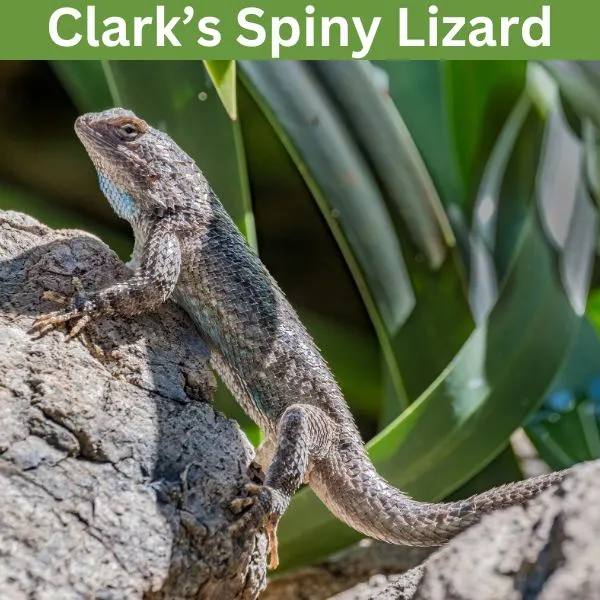
- Experience Level: Intermediate
- Family: Phrynosomatidae
- Scientific Name: Sceloporus clarkii
- Other Names: n/a
- Adult Size: 2.4 to 5.4 in. (6.3 to 13.8 cm)
- Lifespan: Average
- Price Range: n/a
The Clark’s spiny lizard is found in the southwestern corner of New Mexico. Desert, and semi-arid grasslands are habitats this species lives in. They are active in the day, often seen basking on trees, or large rocks.
Clark’s spiny lizards are medium sized, and have gray to tan coloring. They have roughly keeled scales, with blueish or green markings on them. This lizard can have a black collared marking on their neck. They have long tails, with sharp claws used for climbing.
Insects like wasps, beetles, butterflies, and crickets found near plants are what this species eats. They use thick vegetation, or crevices to hide from predators like larger lizards, and birds. The small range of this species, and their secluded habitat is why this species is rarely seen.
20. Dunes Sagebrush Lizard

- Family: Phrynosomatidae
- Scientific Name: Sceloporus arenicolus
- Other Names: n/a
- Adult Size: 2.8 in. (6.5 cm)
- Lifespan: 2 years
- Average Price Range: n/a
Dunes sagebrush lizards are native to New Mexico, and live within a small region within the southeastern corner of the state. These lizards are found in sand dune habitats, and when the surface of the sand gets too hot they retreat in a burrow. Dunes sagebrush lizards are considered a vulnerable species, with the destruction and pollution of their habitat being the main threat they face.
Medium in size, this species has a long tail, with gray to tan coloring. They have a dorsal stripe running down their body. Males have blue coloring on them, while females can have pinkish coloring. Dunes sagebrush lizards are colored to help them blend into their sandy habitats.
This species hibernates in the winter, and in the spring and summer mate, laying their eggs. Insects make up the majority of this species’ diet. They have the second smallest range of all lizards in the United States, and are rarely seen.
21. Common Sagebrush Lizard
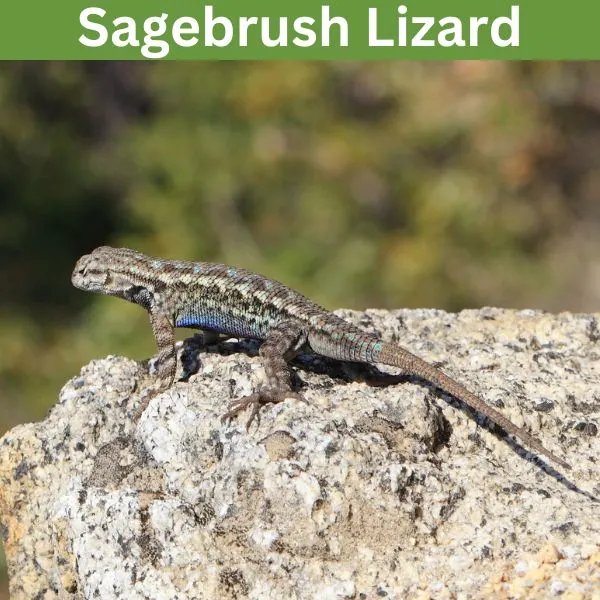
- Experience Level: Intermediate
- Family: Phrynosomatidae
- Scientific Name: Sceloporus graciosus
- Other Names: Sagebrush swift
- Adult Size: 2 to 5.9 in. (5 to 14.98 cm.)
- Lifespan: 5 years
- Average Price Range: n/a
Common sagebrush lizards are found in the northwestern corner of New Mexico. This lizard lives in shrubland, and woodland habitats. They are found on logs, and rocky outcrops. Common sagebrush lizards are active in the morning until the afternoon. They are often seen climbing on things like fences, rocks, and logs.
Sagebrush lizards have olive, tan, or gray coloring, with roughly keeled scales. Males sometimes have blue coloring on their sides, with their bellies being a pale cream color. Dark banding can appear on this lizard’s back, and tail.
Common sagebrush lizards are extremely timid, and if spotted hide in bushes, or burrows. They feed on insects during the day, eating things like ants, beetles, and crickets. Sagebrush lizards mate in the spring, playing around 10 eggs. They are very common in their range, and habitat, with a stable population.
22. Greater Earless Lizard

- Experience Level: Intermediate
- Family: Phrynosomatidae
- Scientific Name: Cophosaurus texanus
- Other Names: n/a
- Adult Size: 2.6 to 5.3 in. (6.6 to 13.4 cm)
- Lifespan: 3 years
- Average Price Range: $15
Greater earless lizards can be found in the southern half of New Mexico. This species is native to the Chihuahuan Desert, and the southwestern United States. Semi-arid grasslands, woodland, and desert habitats is where this species lives. The mornings to evenings is when this species is active most.
Greater earless lizards get their name since they do not have any external ear holes. This species is small to medium sized. They have gray, brown, or reddish brown coloring. This species has dark colors on their back, and tails that are lined shaped. Their bellies may have bluish coloring.
This species is not seen in the winter, as they hibernate during the cold. Greater earless lizards will flee if approached, and they are also territorial with other lizards. Insects like moths, insects, bees, and caterpillars are what they eat.
23. Zebra-tailed Lizard

- Experience Level: Intermediate
- Family: Phrynosomatidae
- Scientific Name: Callisaurus draconoides
- Other Names: n/a
- Adult Size: 7 to 9 in. (17.78 to 22.86 cm.)
- Lifespan: 3 to 5 years
- Average Price Range: $15
Zebra-tailed lizards have a very small range in New Mexico, found in the southwestern corner of the state. This species is found in open deserts, with scarce vegetation. They are active in the day, rising early to avoid the hottest time. This species has the highest population in creosote scrub habitats.
Zebra-tailed lizards are named after their black and white tails, which curls. They have a brown sandy coloring, with males having blotches of blue and black on their sides. This species has a slender body, with long toes.
The summer is when this species breeds, and they lay around 2 to 8 eggs. Zebra-tailed lizards are preyed on by animals like birds, other lizards, and carnivorous mammals. Zebra-tailed lizards eat animals like insects, and spiders, but also eat plant materials like flowers.
24. Regal Horned Lizard

- Experience Level: Intermediate
- Family: Phrynosomatidae
- Scientific Name: Phrynosoma solare
- Other Names: n/a
- Adult Size: 3 to 4 in. (7.6 to 10.16 cm.)
- Lifespan: 5 to 8 years
- Average Price Range: n/a
Regal horned lizards are found in the extreme southwestern region in New Mexico. This species is found in desert habitat with mesquite, creosote bush, and cactus vegetation. They are common in the Sonoran Desert Mountains, and live in hot and dry climates.
This species, like other horned lizards, are covered in spikes all over their body. They have a flat, round body. Their color ranges from yellowish, to tan, with a mottled pattern covering them.
The spikes on this lizard’s body make them less palatable to predators. The coloring and spikes on this species also makes them camouflage better into their habitat. Regal horned lizards feed mainly on ants, but also eat other insects, and spiders.
25. Roundtail Horned Lizard

- Experience Level: Intermediate
- Family: Phrynosomatidae
- Scientific Name: Phrynosoma modestum
- Other Names: n/a
- Adult Size: 2.7 to 4.3 (7 to 10.5 cm)
- Lifespan: 7 years
- Average Price Range: n/a
The roundtail horned lizards are found in the southern half of New Mexico. This species lives in semi-arid habitats with sparse vegetation. They are also found in other states like Texas, Colorado, and Arizona.
This lizard’s color reflects the color of the sand in the habitat they live in. They have tan to gray coloring, with dark marks on their body. The body shape of this lizard is flat and round. They have spikes on their head, and smaller spikes on their body.
This species breeds in the summer, and lays their eggs in soil. Roundtail horned lizards lay around 6 to 19 eggs. They feed mainly on ants, and are common near places with lots of ant hills.
26. Greater Short-horned Lizard

- Experience Level: Intermediate
- Family: Phrynosomatidae
- Scientific Name: Phrynosoma hernandesi
- Other Names: Mountain short-horned lizard
- Adult Size: 6 in. (15 cm.)
- Lifespan: n/a
- Average Price Range: $40
The greater short-horned lizard is found in most of New Mexico, and is found in the majority of the state. Desert habitats and forests are where this lizard lives. They are found in places with loose soil, and lots of sparse vegetation. Compared to other similar species this lizard is more cold tolerant, and is able to be found in higher elevations.
Greater short-horned lizards have flat, round bodies, with short tails, and stumpy limbs. They have coloring ranging from dark brown, reddish brown, tan, or gray. The location is typically what determines this species color. Females of this species are larger than males. Dark blotches may appear on this lizard’s back, and if threatened their colors may become more vibrant.
Insects like ants are what this lizard mainly eats, but they also may feed on other invertebrates. Camouflage is helpful for hiding from prey, but also predators. Greater short-horned lizards are able to squirt blood from their eyes, but they typically only do this to dogs that are attacking them.
27. Texas Horned Lizard
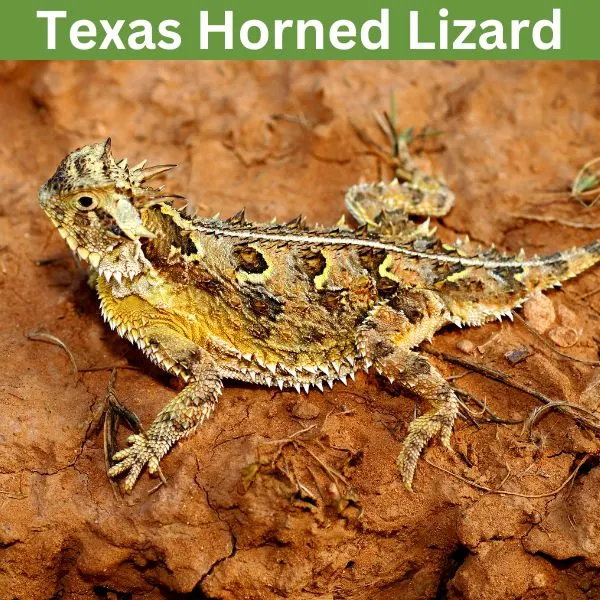
- Experience Level: Advanced
- Family: Phrynosomatidae
- Scientific Name: Phrynosoma cornutum
- Other Names: Horny Toad
- Adult Size: 3.7 to 5 in. (9.93 ot 12.7 cm.)
- Lifespan: 5 years
- Average Price Range: $40
The southeastern half of New Mexico is where the Texas horned lizard can be found. Semi-arid habitats with sparse vegetation is where this lizard lives. Horned lizards like this species are active in the day, and hide within vegetation to stay hidden.
Texas horned lizards are one of the largest horned lizards in New Mexico. This species’ coloring ranges from tan to gray. They have horns covering their bodies and heads, with dark markings on them. Texas horned lizards that are females are slightly larger.
This species is very docile, but is aggressive towards the ants, and other insects they eat. Texas horned lizards are able to shoot blood out of their eyes. Pesticides, and invasive red ants are some of the threats this lizard faces. While this species is the state lizard of Texas, they are also common in New Mexico.
28. Western Earless Lizard

- Experience Level: Intermediate
- Family: Phrynosomatidae
- Scientific Name: Holbrookia maculata
- Other Names: n/a
- Adult Size: 4 to 5 in. (10 to 13 cm.)
- Lifespan: 3 to 7 years
- Average Price Range: n/a
The western earless lizard is common all across New Mexico, and this species is also found in other nearby states. Western earless lizards live in grasslands, shrublands, and desert habitats. This species is active in the day, seen from the spring to fall months.
Western earless lizards have gray, tan, or orangish coloring. They have rows of dark blotches, or chevrons on their body. Males of this species may have yellow, or blue coloring on them. Females when pregnant may have orange, or pinkish shade on them. Like other similar species this lizard lacks external ear holes.
Insects like beetles, grasshoppers, ants, and bees are some of the prey this lizard eats. Western earless lizards mate in the spring, laying around 1 to 10 eggs. This lizard is sighted most in places with loose soil, and sparse vegetation.
29. Elegant Earless Lizard

- Experience Level: Intermediate
- Family: Phrynosomatidae
- Scientific Name: Holbrookia elegans
- Other Names: n/a
- Adult Size: 3 in. (7.62 cm.)
- Lifespan: 3 years
- Average Price Range: $15
Elegant earless lizards are found in a small region within the southwestern corner of New Mexico. This species is found in woodland, and semi-arid environments. They are seen most in the morning, until temperatures get too high. The spring to fall is when these lizards are active most, and also breed during the period.
This lizard is medium-sized, with tan, gray, or orangish coloring. They have light specks on their sides and tail. The body of this lizard may have bluish, or pink hue. Insects like ants, beetles, and other invertebrates are what this lizard eats. They are sometimes seen on warm nights, and hibernate in winter.
Scincidae
30. Many-lined Skink

- Experience Level: Beginner
- Family: Scincidae
- Scientific Name: Plestiodon multivirgatus
- Other Names: Variable Skink, Northern Many-lined Skink
- Adult Size: 3 to 7.5 in. (7.5 to 19 cm.)
- Lifespan: 6 years
- Average Price Range: n/a
The many-lined skink is found in most of New Mexico. This species lives in woodlands, prairies, and foothill habitats. They are sometimes found hiding under debris like larger rocks, or logs. This species is active in the day, and is very quick, zipping from cover to cover.
Many-lined skinks are a small species, with olive, to brown coloring. They have a stripe that runs down their body and tail. This species may have reddish coloring under their chin. Their bodies have a checkered dark pattern on them.
The many lines on this skink is where this species gets its name, and they are a common lizard. Insects, and small invertebrates are what this lizard eats. They nest in the spring, laying up to 9 eggs in dark, secluded areas.
31. Mountain Skink

- Experience Level: Beginner
- Family: Scincidae
- Scientific Name: Plestiodon callicephalus
- Other Names: n/a
- Adult Size: 3 in. (7.5 cm.)
- Lifespan: 2 to 3 years
- Average Price Range: n/a
Mountain skinks are very rare in New Mexico, and are found in the far southwestern corner of the state. This species lives in semidesert, and grassland habitats. They prefer moist areas next to rivers, and often hide under debris like logs. The majority of Mountain skinks are found in Mexico, but in the United States they live near the Mexican border around Arizona and New Mexico.
Mountain skinks are medium sized, with olive, to tan coloring. They have dark stripes that run down their body, with a Y shaped marking on their head. The tail of this lizard like other skinks is blue when born, which may fade with age.
Predators like invasive red ants, larger lizards, and birds are this skinks main threat. They are very rare in New Mexico, and are on the decline due to population loss. This species is terrestrial, and burrows to make a den when not active.
32. Great Plains Skink
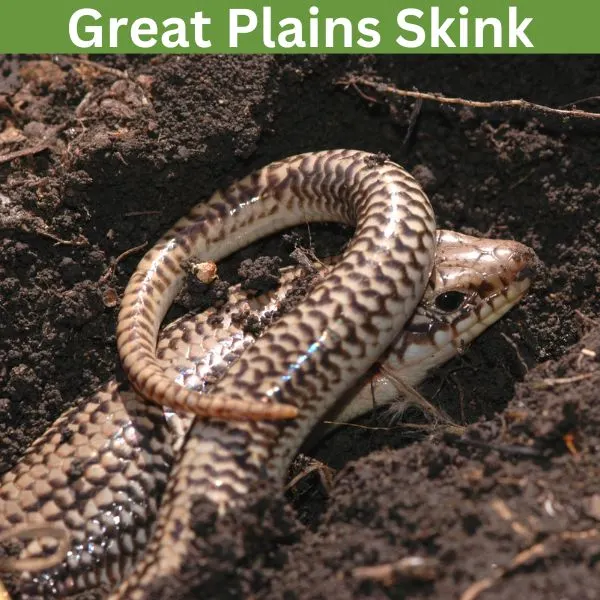
- Experience Level: Beginner
- Family: Scincidae
- Scientific Name: Plestiodon obsoletus
- Other Names: 3.5 to 5.11 in. (9 to 13 cm.)
- Adult Size: 6.5 to 13.75 in. (16.51 to 34.9 cm.)
- Lifespan: 3 years
- Average Price Range: $50
Great plains skinks are one of the most common skinks that live in New Mexico, and can be seen in the majority of the state. Habitats like foothills, mountains, urban areas, and other places near water sources like streams is where this lizard is common. They are active most in the spring, and lay up to 30 eggs in this season.
This skink is the largest that lives in New Mexico, and one of the largest in North America. Great Plains skink have tan, gray, or beige coloring. They have dark markings on them, with yellow bellies. When born this species may have a blue tail, and blue head.
Skins like this species feed on small insects, and other invertebrates. They are able to drop their tail if attacked, and regrow it. Birds, larger lizards, and carnivorous mammals like raccoons are what feed on this lizard.
Gekkonidae
33. Mediterranean House Gecko
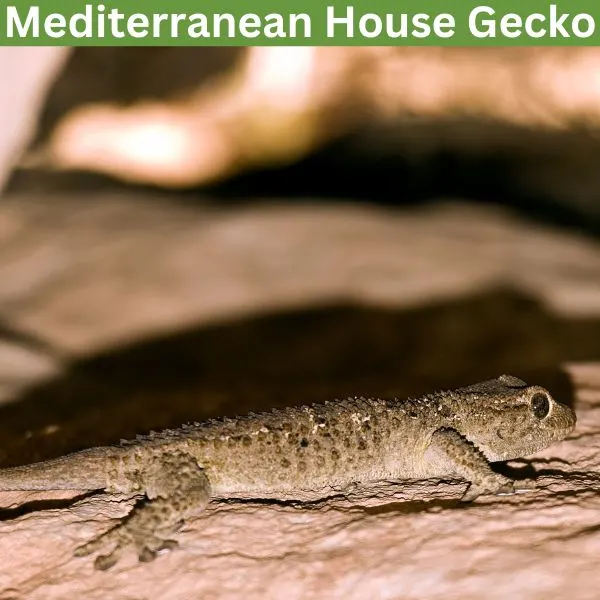
- Experience Level: Beginners
- Family: Gekkonidae
- Scientific Name: Hemidactylus turcicus
- Other Names: Moon Lizard, Turkish Gecko
- Adult Size: 4 to 5 in. (10 to 13 cm.)
- Lifespan: 3 to 9 years
- Average Price Range: $10
Not native to New Mexico, the Mediterranean house gecko is native to the Mediterranean region. This species has become invasive all across the United States, and are found most in urban areas. Active at night, this lizard can be found near light sources, and climbing on walls.
Mediterranean house geckos are cream to tan, and have very bumpy skin. They have yellow elliptical eyes, with large toe pads to help them climb. This gecko has dark spots that cover them, and pointed heads.
This gecko feeds mainly on insects, hunting for things like moths, flies, and mosquitoes at night. They have excellent eyesight, and if spotted they will flee to cover. When active this lizard may make bird-like chirps, used to attract mates, and mark their territory.
Eublepharidae
34. Texas Banded Gecko

- Experience Level: Beginner
- Family: Eublepharidae
- Scientific Name: Coleonyx brevis
- Other Names: n/a
- Adult Size: 4 in. (10 cm.)
- Lifespan: 15 years
- Average Price Range: $40
Texas banded geckos are found in dry, rocky habitats like canyons. They are a secretive species, hiding in crevices of rocks, and within debris. This species is nocturnal, and during the day finds a hidden place to rest.
Texas banded geckos have a slender body, with smooth looking scales. They have short legs, with no toe pads like other geckos. This species has pinkish coloring, with yellowing and brown bands on them. They have elliptical eyes, with a thick tail.
This lizard feeds on insects at night like grasshoppers, spiders, moths, and crickets. They lay eggs in the spring, but only around 1 or 2. This species is very docile, and has a stable population in their range.
35. Western Banded Gecko

- Experience Level: Beginner
- Family: Eublepharidae
- Scientific Name: Coleonyx variegatus
- Other Names: n/a
- Adult Size: 4 to 6 in. (10 to 15.24 cm.)
- Lifespan: 5 to 8 years
- Average Price Range: $60
Western banded geckos live in a small region within the southwestern portion of New Mexico. This lizard is found in desert scrub, and rock semi-arid habitats. They are active at night, and are sighted from the spring to fall months. In winter this lizard hibernates, until next spring.
Western banded geckos are a small lizard with a slender body. They have yellow coloring, with dark brown stripes on them. The belly of this lizard is pale, with no markings. Younger juveniles have dorsal bands on them, which look like blotches. The tail of this lizard is plump, which gets bigger when they are well-fed.
Spiders, insects, and beetles are some of the prey this lizard eats. They are active at night, and will use their great night vision to find food. Western banded geckos prefer warm habitats, and are often found near human structures where food is abundant.
Teiidae
36. New Mexico Whiptail

- Experience Level: Advanced
- Family: Teiidae
- Scientific Name: Aspidoscelis neomexicanus
- Other Names: n/a
- Adult Size: 6.5 to 9.5 in. (16.51 to 24.13 cm.)
- Lifespan: 3 to 7 years
- Average Price Range: n/a
New Mexico whiptails are found in the majority of New Mexico, and are native to the United States. This species lives in grasslands, rocky areas, shrublands, and semi-arid environments. New Mexico whiptails are active in the day, and breed during the spring.
This species is large, with brown, or black coloring. This species has 7 stripes that run down their body. They have a white, or pale blue underside, with a greenish throat. This lizard has a longtail, with a slender body.
New Mexico whiptails occasionally cross breed with the other whiptails in New Mexico. Insects, and small invertebrates are what this species eats. They have a stable population, and are one of the most common lizards in the state.
37. Western Whiptail

- Experience Level: Intermediate
- Family: Teiidae
- Scientific Name: Aspidoscelis tigris
- Other Names: n/a
- Adult Size: 9.8 to 13.7 in. (25 to 35 cm.)
- Lifespan: 7 years
- Average Price Range: n/a
The western whiptail is also called the tiger whiptail, and this species is native to the western United States. This species lives in deserts, woodlands, chaparral, and other habitats with sparse vegetation. They use plants, and burrows to escape the heat in their environment. From spring to fall this species is active, and in the cold months they hibernate.
Western whiptails have a long and slender body. They have tan, to gray coloring, with light stripes that run down their body. When born this species is orange or yellow, and has dark spots on them. Western whiptails have long tails that get very thin towards their end.
Insects, spiders, and scorpions are what these lizards eat. They are able to drop their long tails to escape predators. Cats, birds, and larger lizards are this species’ main predators.
38. Gila Spotted Whiptail

- Experience Level: Advanced
- Family: Teiidae
- Scientific Name: Aspidoscelis flagellicauda
- Other Names: n/a
- Adult Size: 6.5 to 11 in. (16.51 to 28 cm.)
- Lifespan: 3 to 7 years
- Average Price Range: n/a
The gila spotted whiptail is found in a small region within New Mexico, in the southwestern corner of the state. This species lives in semi-arid habitats near streams, and other water sources. They are common in sunny and open areas, and are active in the day.
This species is medium-sized, with brown to black coloring. They have a long body, with a thin tail. Gila spotted whiptails have stripes that run down their body that are yellowish, and when young they may have spots on them.
This species is very speedy, and spends its day feeding on insects. During the breeding season this lizard may lay up to 6 eggs. They enjoy digging in soil, hiding in places like burrows, or under rocks.
39. Marbled Whiptail

- Experience Level: Advanced
- Family: Teiidae
- Scientific Name: Aspidoscelis marmoratus
- Other Names: n/a
- Adult Size: 8 to 12 in. (20.32 to 30.48 cm.)
- Lifespan: 3 to 7 years
- Average Price Range: $20
Marbled spotted whiptails are native to New Mexico, found in the southern portion of the state. Semi-arid, and sandy habitats with sparse vegetation is where this species lives. They are active in the day, and during the colder months spend their lives underground. Marbled whiptails breed in the spring, laying up to 4 eggs.
This lizard is slender, with a long tail, and small head. When born this species has a blue tail, and flecks on them. This species has a gray, or tan coloring, with stripes running down their body. Vegetation is used for this lizard as places to hide if scared. They are very speedy, using their quickness to catch prey.
40. Six-lined Racerunner
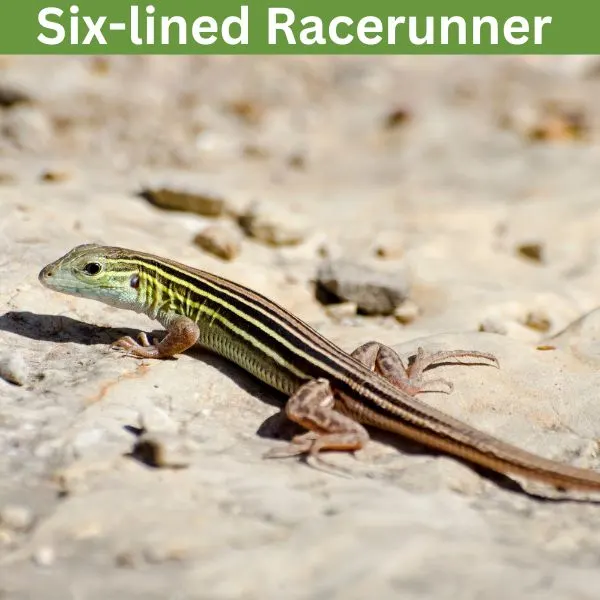
- Experience Level: Intermediate
- Family: Teiidae
- Scientific Name: Aspidoscelis sexlineata
- Other Names: Sandlapper lizard
- Adult Size: 6 to 9.5 in. (15 to 24 cm.)
- Lifespan: 4 to 5 years
- Average Price Range: $30
Six-lined race runners are found in the eastern portion of New Mexico. This species is native to the Great Plains region in the United States. They are found in grasslands, woodlands, rock regions, and floodplain habitats. This lizard prefers lower elevations with moist soil.
This lizard is named after the six lines that run down their back. They have brown, dark green, or black coloring, with yellowish, or reddish stripes on them. Six-lined race runners may have greenish coloring under their throat.
Grasshoppers, beetles, butterflies, and other insects are what this lizard eats. This lizard is preyed on by fire ants, and larger lizards. Six-lined race runners are very common in their range, but in some places like Michigan are considered threated due to their declining population.
41. Common Checkered Whiptail

- Experience Level: Intermediate
- Family: Teiidae
- Scientific Name: Aspidoscelis tesselata
- Other Names: n/a
- Adult Size: 5 to 6 in. (12.7 to 15.24 cm.)
- Lifespan: 4 to 5 years
- Average Price Range: n/a
Common checkered whiptails are native to the southwestern United States, which includes New Mexico. This species is found in rocky, semi-arid habitats. They are active in the day, feeding on insects, and other invertebrates. The eggs of this lizard are laid in the summer, and this species is able to breed asexually.
Common checkered whiptails have a long body, and tail. They have a brown, or black coloring, with stripes, blotches, and a checkered pattern on them. The markings on this lizard are yellowish, and their bellies are white. This lizard is similar to other whiptails in appearance, and has a stable population in their range.
42. Chihuahuan Spotted Whiptail

- Experience Level: Intermediate
- Family: Teiidae
- Scientific Name: Aspidoscelis exsanguis
- Other Names: n/a
- Adult Size: 9.5 to 12 in. (24.13 to 30.48 cm.)
- Lifespan: 3 to 7 years
- Average Price Range: n/a
Chihuahuan spotted whiptails are found in most of New Mexico, and are native to the Chihuahuan and Sonoran deserts in North America. This species is found in semi-arid habitats like dry forests, and deserts grasslands. Active in the day, this lizard’s time is spent preying on insects.
Chihuahuan spotted whiptail are one of the many whiptail species in New Mexico. This lizard has a slender body, with long toes. They have stripes running down their body, with spots on them. The underside of this species is pale.
When breeding this species will dig a hole to lay their eggs. Chihuahuan spotted whiptails are a common species, and not threatened. Other lizards, predatory birds, and mammals are what prey on this species.
43. Common Spotted Whiptail

- Experience Level: Advanced
- Family: Teiidae
- Scientific Name: Aspidoscelis gularis
- Other Names: n/a
- Adult Size: 7 to 9 in. (17.78 to 22.86 cm.)
- Lifespan: 3 to 7 years
- Average Price Range: n/a
Common spotted whiptails are found in the southeastern corner of New Mexico. This species is found in grasslands, and rocky semi-arid environments. They are active in the day, feeding mainly on insects. The spring is when this species mates, and they lay around 5 eggs.
Common spotted whiptails have tan to brown coloring. They have stripes that run down their body, with spots on their sides. Males of this species have reddish throats and a blue belly, while females may have pinkish coloring. Common spotted whiptails have a stable population, and are found near the semi-arid regions of the southern United States.
44. Desert Grassland Whiptail

- Experience Level: Advanced
- Family: Teiidae
- Scientific Name: Aspidoscelis uniparens
- Other Names: n/a
- Adult Size: 2.75 to 5.25 in. (7 to 13 cm.)
- Lifespan: 7 years
- Average Price Range: n/a
In New Mexico the desert grassland whiptail is found in the western part of the state. This species lives in desert habitats. They are active during the day, and spend their time feeding on insects like ants, and termites. This species is able to reproduce without male fertilization.
Desert grassland whiptails are a small species,with six yellow lines running down their body. This species has a base color of tan, or olive, and they have a blue tail when young. Desert grassland lizards have a stable population, but are often confused with other similar species.
45. Plateau Striped Whiptail

- Experience Level: Intermediate
- Family: Teiidae
- Scientific Name: Aspidoscelis velox
- Other Names: n/a
- Adult Size: 2 to 5 in. (5 to 12.7 cm.)
- Lifespan: 7 years
- Average Price Range: n/a
The plateau striped whiptail has a large range in New Mexico, which covers the northwestern half of the state. This species is native to New Mexico, but has been introduced to other states like Oregon. Active in the day, this lizard is found in semi-arid grasslands, woodlands, and canyon habitats.
This species has a similar appearance to other whiptails. Plateau striped whiptails have a blue tail, with yellowish stripes running down there. These whiptails have a gray, tan, or olive base coloring, with a pale underside.
Insects, spiders, and other invertebrates are what this species eats, and they forage near rocks, or logs. A very quick lizard, they use their speed to catch prey, and escape predators.
46. Little Striped Whiptail

- Experience Level: Advanced
- Family: Teiidae
- Scientific Name: Aspidoscelis inornatus
- Other Names: n/a
- Adult Size: 6.5 to 9.5 in. (17 to 24 cm.)
- Lifespan: 3 to 7 years
- Average Price Range: n/a
Little striped whiptails are native to the southwestern United States, which includes New Mexico, Texas, and Arizona. This species lives in grasslands, and semi-arid rocky environments. They are active in the day, breeding during the spring and early summer months.
Little striped whiptails are medium sized, with black, yellow, and white coloring. They have stripes running down their body, with blue coloring on their tail. This lizard’s blue coloring is more prominent on males of the species.
A very speedy lizard, this species used plants like cacti to hide. When breeding they lay around 2 to 4 eggs, and overall their population is stable. Little striped whiptails are found in most of New Mexico, with their populations spread across the state.
FAQ
Why are there so many lizard species in New Mexico?
The diverse types of habitat is why there are such a variety of lizard species that live in New Mexico. Lizards are common in arid environments like deserts. New Mexico is home to the Chihuahuan desert, which is filled with lots of lizard species.
Are there any dangerous lizards in New Mexico?
The GIla monster is the only venomous lizard that lives in the United States, and can be found in New Mexico. Gila monsters use their grooved teeth to administer venom, and despite their bites being rarely life threatening they can cause a myriad of symptoms like pain, swelling, and vomiting.
What is the largest lizard in New Mexico?
The gila monster is the largest lizard in New Mexico and is capable of weighing up to 2 lbs, and growing up to 22 in (56 cm.) in length. Gila monsters have beaded scales, and have orange and black coloring. Despite their size these lizards are rarely seen due to their secretive burrowing nature.
Wrapping up
New Mexico is home to around 46 lizard species, but in the future more may be discovered living in the state. Overall there are more than 100 reptile and amphibian species that live within New Mexico, which includes snakes, turtles, frogs, salamanders, and toads. Animals like these are fun to spot in the wild, and play an important role in keeping their ecosystems balanced.
Lizards are a useful food source for animals like birds, carnivorous mammals, and other reptiles. Lizards are also helpful in controlling the pest population of insects and other invertebrates. Keeping a healthy environment is essential in protecting the animals that live within these ecosystems. Some lizards are endangered, or losing population, and learning about the various species in New Mexico is an important step in keeping their populations healthy.
Other lizards in nearby states
